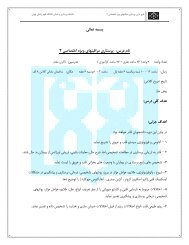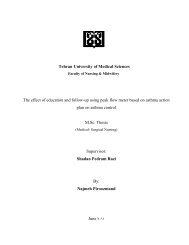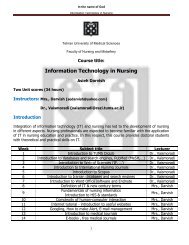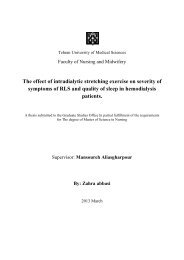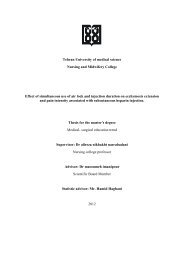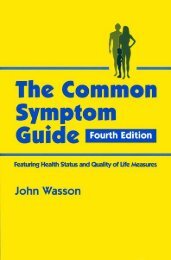Cohort Studies - Introduction
Cohort Studies - Introduction
Cohort Studies - Introduction
Create successful ePaper yourself
Turn your PDF publications into a flip-book with our unique Google optimized e-Paper software.
<strong>Cohort</strong> <strong>Studies</strong>
ياب<br />
حالا کجاييم؟<br />
طرح کلي<br />
ويژگي ها<br />
هم گروه تاريخي<br />
ارزي<br />
مواجهه<br />
همسان سازي<br />
مقايسه با مطالعه مورد شاهد<br />
تجزيه و تحليل<br />
•<br />
•<br />
•<br />
•<br />
•<br />
•<br />
•
<strong>Cohort</strong> <strong>Studies</strong> - Definition<br />
What is a “<strong>Cohort</strong>” <br />
1. One of 10 divisions in Roman legion<br />
2. “Band” or “Group”<br />
Source: Webster’s Third International Dictionary. 1993.
COHORT STUDIES<br />
• <strong>Cohort</strong> Study<br />
– Key Point:<br />
– Presence or absence of risk factor<br />
is determined before outcome<br />
occurs.
Comparing <strong>Cohort</strong> <strong>Studies</strong> with<br />
Randomized Trials<br />
Interventional Study<br />
Study group<br />
Observational Study<br />
Study group<br />
Random Allocation<br />
No Allocation<br />
Group A Group B Group A Group B
Why cohort studies instead RCTs<br />
• Unable to randomize<br />
– Impossible: genetic traits<br />
– Unethical: desperate disease (CA)<br />
– Illegal: effect of cocaine use during pregnancy<br />
• Interested in incidence rates or predictors more<br />
than the effects of interventions<br />
– e.g. predictive role of initial BP in field in blunt trauma<br />
• Field of investigation is immature<br />
• Limited research resources<br />
– time, money, subjects
Design of a <strong>Cohort</strong> Study<br />
• Prospective / incidence / longitudinal study<br />
• Investigator selects a group of exposed<br />
individuals & a group of nonexposed<br />
individuals<br />
• Can be 1 group: special exposure groups, or<br />
survival studies<br />
• Follow up both groups to compare<br />
incidence of disease (or rate of death from<br />
disease) in the 2 groups<br />
– Could include more than 2 groups
بررسي ارتباط خونريزي واژينال نيمه اول بارداري با<br />
سرانجام بارداري، در بيمارستانهاي آموزشي تهران.<br />
بررسي خطر شروع استفاده از اکستاسي در دوستان<br />
فرد مصرف کننده.<br />
بررسي ميزان بقا و عوارض ريوي ناشي از گاز خردل<br />
در مصدومين شيميايي جنگ تحميلي<br />
مطالعه هم گروهي براي تعيين عوامل خطر زاي<br />
سرطان مري در استان گلستان<br />
•<br />
•<br />
•<br />
•
Design of a cohort study<br />
Disease Status<br />
Yes<br />
No<br />
Total<br />
Exposure<br />
Status<br />
Yes<br />
No<br />
a<br />
c<br />
b<br />
d<br />
a +b<br />
c +d<br />
a +c<br />
b +d<br />
N
Design of a cohort study<br />
Disease Status<br />
Yes<br />
No<br />
Total<br />
Exposure<br />
Status<br />
Yes<br />
No<br />
a<br />
c<br />
b<br />
d<br />
a +b<br />
c +d<br />
a +c<br />
b +d<br />
N
Design of a <strong>Cohort</strong> Study<br />
Disease<br />
Yes No<br />
Totals<br />
Incidence of<br />
Disease<br />
Yes<br />
a<br />
b<br />
a + b<br />
a / (a + b)<br />
Exposure<br />
No<br />
c<br />
d<br />
c + d<br />
c/ (c + d)
Selection of Study Groups : 1<br />
Defined<br />
Population<br />
God-Randomized<br />
Exposed<br />
Not Exposed<br />
Disease<br />
No Disease<br />
Disease<br />
No Disease
Selection of Study Groups : 2<br />
No Disease Exposure to Disease<br />
Risk Factor<br />
Yes<br />
Exposed<br />
No<br />
Population<br />
without<br />
disease<br />
Sample<br />
Time<br />
Not Exposed<br />
Yes<br />
No
ياب<br />
حالا کجاييم؟<br />
طرح کلي<br />
ويژگي ها<br />
هم گروه تاريخي<br />
ارزي<br />
مواجهه<br />
همسان سازي<br />
مقايسه با مطالعه مورد شاهد<br />
تجزيه و تحليل<br />
•<br />
•<br />
•<br />
•<br />
•<br />
•<br />
•
ويژگي هاي مطالعه<br />
امکان در نظر گرفتن هم زمان چندين پي آمد ناشي از<br />
مواجهه مورد بررسي<br />
مناسب بودن براي مواجهه هاي کم ياب<br />
طولاني بودن مدت مطالعه بسته به فاصله زماني بين<br />
مواجهه و پي آمد<br />
هزينه بيشتر نسبت به ساير مطالعه هاي مشاهده اي<br />
کم بودن امکان سوگرايي اطلاعات در مطالعه هم<br />
گروهي، نسبت به مطالعه مورد شاهدي<br />
•<br />
•<br />
•<br />
•<br />
•
در نظر گرفتن هم زمان چندين پي آمد ناشي از<br />
مواجهه مورد بررسي<br />
خونريزي واژينال:<br />
–<br />
–<br />
–<br />
زايمان زودرس<br />
وزن پايين نوزاد<br />
مرگ حول تولد<br />
•<br />
چندين پي آمد<br />
مواجهه هاي کم ياب<br />
طولاني بودن مدت<br />
هزينه بيشتر<br />
کم بودن امکان سوگرايي اطلاعات<br />
•<br />
•<br />
•<br />
•<br />
•
مناسب بودن برا ي مواجهه هاي کم<br />
ياب<br />
بررسي ميزان بقا و عوارض ريوي ناشي از گاز خردل<br />
در مصدومين شيميايي جنگ تحميلي<br />
•<br />
چندين پي آمد<br />
مواجهه هاي کم ياب<br />
طولاني بودن مدت<br />
هزينه بيشتر<br />
کم بودن امکان سوگرايي اطلاعات<br />
•<br />
•<br />
•<br />
•<br />
•
طولان ي بودن مدت مطالعه بسته به فاصله<br />
زماني بين مواجهه و پي آمد<br />
مطالعه هم گروهي براي تعيين عوامل خطر زاي<br />
سرطان مري در استان گلستان<br />
•<br />
چندين پي آمد<br />
مواجهه هاي کم ياب<br />
طولاني بودن مدت<br />
هزينه بيشتر<br />
کم بودن امکان سوگرايي اطلاعات<br />
•<br />
•<br />
•<br />
•<br />
•
ويژگي هاي مطالعه<br />
چندين پي آمد<br />
مواجهه هاي کم ياب<br />
طولاني بودن مدت<br />
هزينه بيشتر<br />
کم بودن امکان سوگرايي اطلاعات<br />
•<br />
•<br />
•<br />
•<br />
•
باياس ها<br />
سو گرايي اطلاع: اگر اندازه گيري پيامد در گروه<br />
داراي مواجهه و گروه مقابل متفاوت باشد باياس جدي<br />
ايجاد مي شود.<br />
سوگرايي انتخاب:<br />
Loss to follow up<br />
•<br />
•<br />
•
Minimizing “lost to F/U”<br />
• Exclude those likely to become “lost”<br />
– Planning to move<br />
– Unwilling to return<br />
• Obtain complete tracking info<br />
– Address, phone<br />
– Same for friend or close relative<br />
– Primary MD<br />
• Maintain periodic contact<br />
– Reminders, updates<br />
• Use secondary data sources for critical info<br />
– Death registries, Medicare records, voter/driver registration
ياب<br />
حالا کجاييم؟<br />
طرح کلي<br />
ويژگي ها<br />
هم گروه تاريخي<br />
ارزي<br />
مواجهه<br />
همسان سازي<br />
مقايسه با مطالعه مورد شاهد<br />
تجزيه و تحليل<br />
•<br />
•<br />
•<br />
•<br />
•<br />
•<br />
•
Types of <strong>Cohort</strong> <strong>Studies</strong>: Concurrent<br />
Concurrent<br />
2004<br />
Defined<br />
Population<br />
Non-Randomized<br />
Exposed<br />
Not Exposed<br />
2020<br />
Disease<br />
No Disease<br />
Disease<br />
No Disease
Types of <strong>Cohort</strong> <strong>Studies</strong>: Retrospective<br />
Defined<br />
Population<br />
Retrospective<br />
1980<br />
Non-Randomized<br />
Exposed<br />
Not Exposed<br />
Disease<br />
No Disease<br />
Disease<br />
No Disease<br />
2004
Types of <strong>Cohort</strong> <strong>Studies</strong><br />
• Concurrent cohort study<br />
– Concurrent, prospective, or longitudinal study
Types of <strong>Cohort</strong> <strong>Studies</strong><br />
• Problems with concurrent cohort studies<br />
–Time<br />
• Risk that study subjects will outlive the investigator<br />
• Risk that investigator will not survive to the end of<br />
the study<br />
– Loss to follow up
Types of <strong>Cohort</strong> <strong>Studies</strong><br />
• Retrospective cohort study<br />
– Historical cohort or Nonconcurrent<br />
prospective or retrospective cohort study<br />
– Study design is same as in concurrent cohort<br />
design.<br />
– Exposure is ascertained from past records
Types of <strong>Cohort</strong> <strong>Studies</strong><br />
• Combination of concurrent cohort &<br />
retrospective cohort designs<br />
(bidirectional)<br />
– Exposure is ascertained from objective records<br />
in the past (historical cohort study)<br />
– Follow-up and measurement of outcome<br />
continue into the future
Types of <strong>Cohort</strong> <strong>Studies</strong><br />
Past Present Future<br />
<strong>Cohort</strong> Follow-up<br />
Assembled<br />
= Historical (retrospective)<br />
Prospective =<br />
<strong>Cohort</strong> Follow-up<br />
Assembled<br />
Mixed <strong>Cohort</strong>
ياب<br />
حالا کجاييم؟<br />
طرح کلي<br />
ويژگي ها<br />
هم گروه تاريخي<br />
ارزي<br />
مواجهه<br />
همسان سازي<br />
مقايسه با مطالعه مورد شاهد<br />
تجزيه و تحليل<br />
•<br />
•<br />
•<br />
•<br />
•<br />
•<br />
•
ارزي ياب<br />
مواجهه<br />
• British doctors study<br />
• گروه هاي شغلي
Exposure measurement<br />
• Measurement of exposure:<br />
– 1) Intensity 2) Duration 3) Onset time ۴)<br />
Intervals of measurement<br />
• Pack-year
The element of “exposure”<br />
• The “classic” cohort studies compared an exposed<br />
group to an unexposed group<br />
• However, that is simply an extreme case of<br />
differences between two groups.<br />
• Other “differences” are also possible:<br />
– High exposure vs. low exposure<br />
– Exposure 1 vs. exposure 2<br />
– Presence of factor 1 vs. factor 2<br />
– Intervention 1 vs. 2
وجود و يا عدم وجود بيماري در ابتداي<br />
مطالعه<br />
بررسي ميزان بقا و عوارض ريوي ناشي از گاز خردل<br />
در مصدومين شيميايي جنگ تحميلي<br />
مطالعه هم گروهي براي تعيين عوامل خطر زاي<br />
سرطان مري در استان گلستان<br />
•<br />
•
Follow-up<br />
• To obtain data about outcome to be determined<br />
(morbidity or death)<br />
– Mailed questionnaire, telephone calls, personal interviews<br />
– Periodic medical examination<br />
– Reviewing records<br />
– Surveillance of death records<br />
– Follow up is the most critical part of the study<br />
• Some loss to follow up is inevitable due to death<br />
change of address, migration, change of occupation.<br />
• Loss to follow-up is one of the draw-back of the<br />
cohort study.
ياب<br />
حالا کجاييم؟<br />
طرح کلي<br />
ويژگي ها<br />
هم گروه تاريخي<br />
ارزي<br />
مواجهه<br />
همسان سازي<br />
مقايسه با مطالعه مورد شاهد<br />
تجزيه و تحليل<br />
•<br />
•<br />
•<br />
•<br />
•<br />
•<br />
•
<strong>Cohort</strong> studies: Matching<br />
• Pair matching<br />
– Each study subject is closely matched with a control<br />
subject on some specific factor<br />
– Requires special statistical tests in the analysis to adjust<br />
for the confounding effects of the matching<br />
• Frequency matching<br />
– Each study subject or group of subjects are matched with<br />
controls on some category of a factor<br />
• e.g. by gender, or age within 5 years, smoker<br />
– Generally does not require special statistical tests in the<br />
analysis
Decisions about matching<br />
• Current statistical techniques allow adjustment for<br />
confounders, so matching not as important as before<br />
• If have a known powerful confounder or one that is difficult<br />
to measure precisely<br />
– Pair match on that confounder<br />
• For most other possible confounders, better to just adjust<br />
in the analysis<br />
• If match on a factor, less able to study its role in the dz.<br />
• Use frequency matching to prevent gross imbalances<br />
between groups that would decrease the power of the study
ياب<br />
حالا کجاييم؟<br />
طرح کلي<br />
ويژگي ها<br />
هم گروه تاريخي<br />
ارزي<br />
مواجهه<br />
همسان سازي<br />
مقايسه با مطالعه مورد شاهد<br />
تجزيه و تحليل<br />
•<br />
•<br />
•<br />
•<br />
•<br />
•<br />
•
Strengths and Weaknesses<br />
Strengths<br />
Weaknesses<br />
• Useful for rare exposures<br />
• (special exposure groups)<br />
• Multiple effects of single<br />
exposure<br />
• Temporal relationship<br />
between exposure and<br />
outcome ascertained<br />
• Direct measurement of<br />
incidence<br />
• Inefficient for rare diseases<br />
• Expensive<br />
• Requires excellent follow-up<br />
• Losses to follow-up can<br />
invalidate the study
ياب<br />
حالا کجاييم؟<br />
طرح کلي<br />
ويژگي ها<br />
هم گروه تاريخي<br />
ارزي<br />
مواجهه<br />
همسان سازي<br />
مقايسه با مطالعه مورد شاهد<br />
تجزيه و تحليل<br />
•<br />
•<br />
•<br />
•<br />
•<br />
•<br />
•
ANALYSIS<br />
• Calculation of incidence rates among<br />
exposed and non exposed groups<br />
• Estimation of risk
Incidence rates of outcome<br />
Disease Status<br />
Yes<br />
No<br />
Total<br />
Exposure<br />
Status<br />
Yes<br />
No<br />
a<br />
c<br />
b<br />
d<br />
a+b<br />
c+d<br />
Study<br />
cohort<br />
Comparison<br />
cohort<br />
a+c<br />
b+d<br />
N
Incidence rate<br />
• Incidence among exposed =<br />
a<br />
a+b<br />
• Incidence among non-exposed =<br />
c<br />
c+d
Estimation of risk<br />
• Relative Risk<br />
incidence of disease among exposed<br />
RR = ______________________________<br />
Incidence of disease among non-exposed<br />
a/a+b<br />
= _________<br />
c/c+d
Estimation of Risk<br />
• Attributable Risk<br />
Incidence of disease among exposed –<br />
incidence of disease among non exposed<br />
AR = _______________________________<br />
Incidence of disease among exposed<br />
a/a+b – c/c+d<br />
AR = _______________<br />
a/a+b
Smoking Lung cancer Total<br />
YES<br />
NO<br />
YES 70 6930 7000<br />
NO 3 2997 3000<br />
73 9927 10000<br />
Find out RR and AR for above data
• Incidence of lung cancer among smokers<br />
70/7000 = 10 per 1000<br />
• Incidence of lung cancer among non-smokers<br />
3/3000 = 1 per thousand<br />
RR = 10 / 1 = 10<br />
(lung cancer is 10 times more common among<br />
smokers than non smokers)<br />
AR = 10 – 1 / 10 X 100<br />
= 90 %<br />
(90% of the cases of lung cancer among smokers are<br />
attributed to their habit of smoking)
Estimation of Risk<br />
• Population Attributable Risk<br />
Incidence of disease among population –<br />
incidence of disease among non exposed<br />
PAR = _______________________________<br />
Incidence of disease among population
Smoking Lung cancer Total<br />
YES<br />
NO<br />
YES 70 6930 7000<br />
NO 3 2997 3000<br />
73 9927 10000<br />
Find out PAR for above data<br />
If prevalence of exposure in population = 20%



